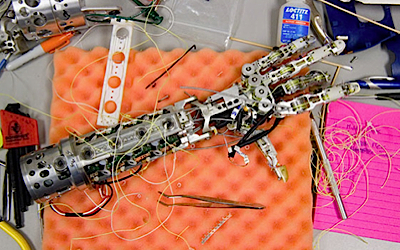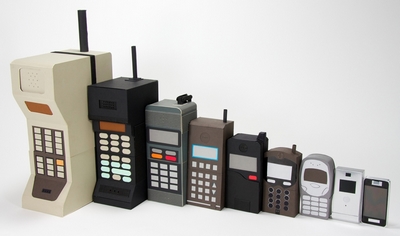We can rebuild him — we have the technology
 It looks like the bionically rebuild, crashed astronaut Steve Austin from the seventies tv-show the Six Million Dollar Man is not so farfetched after all. He’d probably be a bit more expensive today but nonetheless. Recently 51 year Peter Lane was one of the first people in the world outfitted with ‘bionic’ eyes. Peter Lane hasn’t seen the light in over thirty years and can now see outlines of objects such as doorways and furniture . He also has the ability to read though the reading is limited to small words. Cameras built into his glasses send the images to a processor worn on his belt where they are turned into an electronic signal. This signal is sent back to the glasses and transmitted wirelessly to a tiny receiver and electrode panel implanted on his retina. However, it’s still earlier days before the blind can see as well as people with healthy eyesight. Lane says the way he sees cars is as cotton wool but progress is definitely made. Bionic body replacement parts may become readily available sooner than you think. Head over to Wired for a great overview of bionic arms currently under development.
It looks like the bionically rebuild, crashed astronaut Steve Austin from the seventies tv-show the Six Million Dollar Man is not so farfetched after all. He’d probably be a bit more expensive today but nonetheless. Recently 51 year Peter Lane was one of the first people in the world outfitted with ‘bionic’ eyes. Peter Lane hasn’t seen the light in over thirty years and can now see outlines of objects such as doorways and furniture . He also has the ability to read though the reading is limited to small words. Cameras built into his glasses send the images to a processor worn on his belt where they are turned into an electronic signal. This signal is sent back to the glasses and transmitted wirelessly to a tiny receiver and electrode panel implanted on his retina. However, it’s still earlier days before the blind can see as well as people with healthy eyesight. Lane says the way he sees cars is as cotton wool but progress is definitely made. Bionic body replacement parts may become readily available sooner than you think. Head over to Wired for a great overview of bionic arms currently under development.
Blue energy, the hidden power of water

This week Norway opened a prototype of an osmotic power plant near Oslo that generates clean, renewable energy from water. Osmotic power plants can be a welcome addition to other clean, renewable energy sources such as solar, wind and geothermal power. It harnesses the global potential to generate as much energy as China consumed in 2002. Read more
Instant photorealistic 3D cloud computing

You may think that’s a photograph of the interior of a car but your wrong. Not about the interior but about the photograph. It’s not real. It’s a rendered 3D model.
Big deal. Any powerful desktop computer fitted with the latest powerhouse graphics card can render a photorealistic 3D model given enough time. You’re absolutely right. But this photorealistic image was rendered in real-time using ray tracing. But it’s more, a lot more. You can render it real-time on any computing device that supports a browser or standard Web services calls, including netbooks and smartphones. How is that possible? Read more
Focus on the future: the Bionic lens

Even though I’m nearsighted I don’t see myself wearing contact lenses in the near future. It’s a love-hate relationship. I hate them because they irritate my eyes and yes, I’ve tried them for several years. So I wear glasses but would love to be able to wear contact lenses. Not so much because a choice of shades would be nice but but because of what the future of contact lenses may hold in store for us. Let’s take a brief look at what the labrats are working on. Read more
When virtual worlds become ever so real
Virtual worlds are becoming so realistic. The recently released Call of Duty: Modern Warfare 2 has been praised for it’s realism. One reviewer wrote: ‘Some of these unsettling feelings stem from just how incredibly realistic the game looks. The visuals are astounding, and each environment – from snowy mountains in eastern Europe to the favelas of Brazil and a wartorn Washington D.C. – is captured with intricate detail.’
Of course you can take realism to the extreme. And who else but The Onion could come up with this brilliant WORLD EXCLUSIVE. It details Modern Warfare 3, which developer Infinity Ward is apparently putting the “final touches on.. This parody sequel brings true realism of the modern day soldier’s life to your desktop: endless paperwork, boredom and neverending, uneventful routine patrolling in photo realistic detail.
Singularity and the art of mobile evolution

UK based designer Kyle Bean’s Russian Babushka doll style design of the evolution of the mobile phone is not only original, it’s also very telling. He beautifully objectified a piece of recent technological history. His ‘Mobile Evolution’ could be an illustration straight out of futurist Ray Kurzweil’s 2005 bestseller, “The Singularity Is Near: When Humans Transcend Biology”.
In the book Kurzweil examines the next step in the evolutionary process, the singularity, a moment in the future when humans and machines merge and become one. Kurzweil believes this will happen rather sooner then later because exponential growth in scientific and technological developments drives us toward the singularity at an almost unimaginable high pace. Read more





